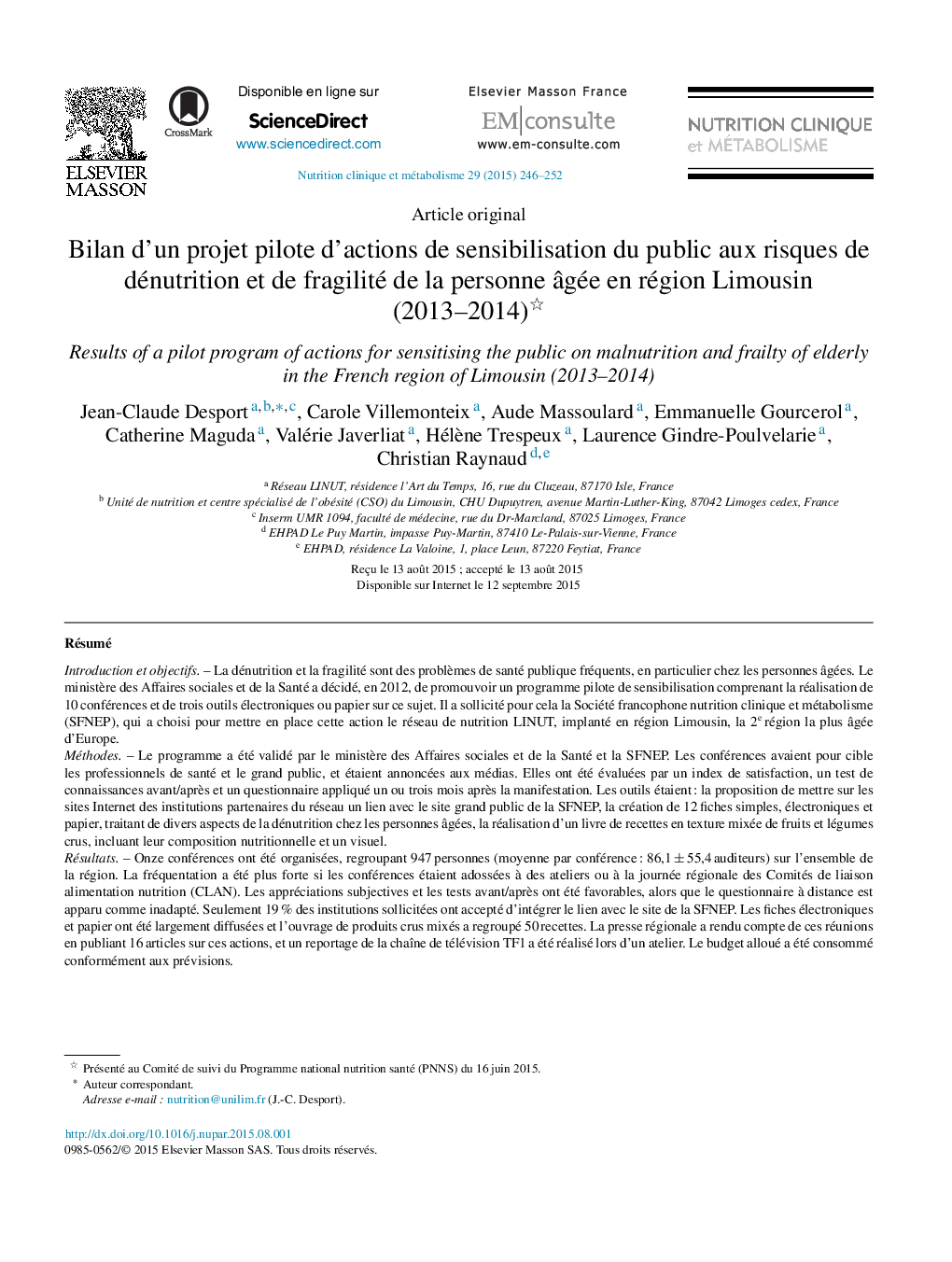| Article ID | Journal | Published Year | Pages | File Type |
|---|---|---|---|---|
| 2688695 | Nutrition Clinique et Métabolisme | 2015 | 7 Pages |
RésuméIntroduction et objectifsLa dénutrition et la fragilité sont des problèmes de santé publique fréquents, en particulier chez les personnes âgées. Le ministère des Affaires sociales et de la Santé a décidé, en 2012, de promouvoir un programme pilote de sensibilisation comprenant la réalisation de 10 conférences et de trois outils électroniques ou papier sur ce sujet. Il a sollicité pour cela la Société francophone nutrition clinique et métabolisme (SFNEP), qui a choisi pour mettre en place cette action le réseau de nutrition LINUT, implanté en région Limousin, la 2e région la plus âgée d’Europe.MéthodesLe programme a été validé par le ministère des Affaires sociales et de la Santé et la SFNEP. Les conférences avaient pour cible les professionnels de santé et le grand public, et étaient annoncées aux médias. Elles ont été évaluées par un index de satisfaction, un test de connaissances avant/après et un questionnaire appliqué un ou trois mois après la manifestation. Les outils étaient : la proposition de mettre sur les sites Internet des institutions partenaires du réseau un lien avec le site grand public de la SFNEP, la création de 12 fiches simples, électroniques et papier, traitant de divers aspects de la dénutrition chez les personnes âgées, la réalisation d’un livre de recettes en texture mixée de fruits et légumes crus, incluant leur composition nutritionnelle et un visuel.RésultatsOnze conférences ont été organisées, regroupant 947 personnes (moyenne par conférence : 86,1 ± 55,4 auditeurs) sur l’ensemble de la région. La fréquentation a été plus forte si les conférences étaient adossées à des ateliers ou à la journée régionale des Comités de liaison alimentation nutrition (CLAN). Les appréciations subjectives et les tests avant/après ont été favorables, alors que le questionnaire à distance est apparu comme inadapté. Seulement 19 % des institutions sollicitées ont accepté d’intégrer le lien avec le site de la SFNEP. Les fiches électroniques et papier ont été largement diffusées et l’ouvrage de produits crus mixés a regroupé 50 recettes. La presse régionale a rendu compte de ces réunions en publiant 16 articles sur ces actions, et un reportage de la chaîne de télévision TF1 a été réalisé lors d’un atelier. Le budget alloué a été consommé conformément aux prévisions.ConclusionUn programme de ce type est applicable, et paraît efficace quant au nombre de personnes concernées par les conférences, la diffusion des outils et l’impact médiatique.
Introduction and objectivesMalnutrition and frailty are frequent public health problems, in particular in the elderly people. The French Ministry for the Social Affairs and Health (MSAH) decided in 2012 to promote a pilot program including the realization of 10 conferences and three electronic or paper tools on this subject. It requested in this direction the French-speaking Clinical Nutrition and Metabolism Society (SFNEP), which chose for its application the nutrition network LINUT, established in area of Limousin, the 2nd oldest area of Europe.MethodsThe program was validated by the MSAH and the SFNEP. The conferences had as a target the health professionals and the general public, and were announced with the media. They were evaluated by an index of satisfaction, a general knowledge before/after test and a questionnaire applied one or three months after the conferences. The tools were: the proposal to put on the websites of the institutions partners of the network a link with the site general public of the SFNEP, the creation of 12 simple, electronic and paper cards, treating various aspects of malnutrition in the elderly, the realization of one recipe book in mixed-texture of raw fruit and vegetables, including their nutritional composition and visual.ResultsEleven conferences took place, involving 947 people (average: 86.1 ± 55.4) on the whole of the area. The frequentation was stronger if the conferences were leaned with workshops or the regional day of the Liaison Committees for Alimentation and Nutrition (LCANs). The subjective appreciations and the before/after tests were favourable, whereas the remote questionnaire appeared unsuited. Only 19% of the requested institutions agreed to integrate the link with the site of the SFNEP. The electronic and paper cards were widely diffused. The book included 50 mixed-texture cooking recipes. The regional press published 16 articles on these actions, and a TF1 report was carried out at the time of a workshop. The allocated budget was consumed in accordance with the forecasts.ConclusionA program of this type is applicable, and appears effective as for the number of people concerned with the conferences, the diffusion of the tools and the media impact.
